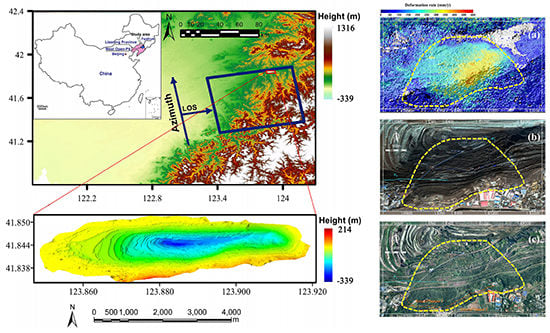Mapping Two-Dimensional Deformation Field Time-Series of Large Slope by Coupling DInSAR-SBAS with MAI-SBAS
Abstract
:1. Introduction
2. Study Area and SAR Data


| No. | Sensor | Beam Mode | Track | Orbit Direction | Polarization | Acquisition Date |
|---|---|---|---|---|---|---|
| 1 | PALSAR | FBS | 433 | Ascending | HH | 9 January 2007 |
| 2 | PALSAR | FBS | 433 | Ascending | HH | 12 January 2008 |
| 3 | PALSAR | FBS | 433 | Ascending | HH | 27 February2008 |
| 4 | PALSAR | FBS | 433 | Ascending | HH | 13 April 2008 |
| 5 | PALSAR | FBS | 433 | Ascending | HH | 29 November 2008 |
| 6 | PALSAR | FBS | 433 | Ascending | HH | 14 January 2009 |
| 7 | PALSAR | FBS | 433 | Ascending | HH | 1 March 2009 |
| 8 | PALSAR | FBS | 433 | Ascending | HH | 17 January 2010 |
| 9 | PALSAR | FBS | 433 | Ascending | HH | 4 March 2010 |
| 10 | PALSAR | FBS | 433 | Ascending | HH | 19 April 2010 |
| 11 | PALSAR | FBS | 433 | Ascending | HH | 20 January 2011 |
3. Methodology



4. Data Processing and Results

| No. | Dates of Masters | Dates of Slaves | Perpendicular Baseline (m) | Temporal Baseline (d) | Subsets |
|---|---|---|---|---|---|
| 1 | 12 January 2008 | 27 February 2008 | 607 | 46 | 1 |
| 2 | 12 January 2008 | 13 April 2008 | 1031 | 92 | 1 |
| 3 | 12 January 2008 | 17 January 2010 | −1126 | 736 | 1 |
| 4 | 12 January 2008 | 4 March 2010 | −526 | 782 | 1 |
| 5 | 12 January 2008 | 19 April 2010 | −286 | 828 | 1 |
| 6 | 12 January 2008 | 20 January 2011 | 1115 | 1104 | 1 |
| 7 | 19 April 2010 | 27 February 2008 | 892 | −782 | 1 |
| 8 | 19 April 2010 | 13 April 2008 | 1317 | −736 | 1 |
| 9 | 19 April 2010 | 17 January 2010 | −841 | −92 | 1 |
| 10 | 19 April 2010 | 4 March 2010 | −242 | −46 | 1 |
| 11 | 19 April 2010 | 20 January 2011 | 1399 | 276 | 1 |
| 12 | 9 January 2007 | 29 November 2008 | -285 | 690 | 2 |
| 13 | 9 January 2007 | 14 January 2009 | 525 | 736 | 2 |
| 14 | 9 January 2007 | 1 March 2009 | 767 | 782 | 2 |
| 15 | 27 February 2008 | 13 April 2008 | 424 | 46 | 1 |
| 16 | 27 February 2008 | 4 March 2010 | −1134 | 736 | 1 |
| 17 | 27 February 2008 | 20 January 2011 | 509 | 1058 | 1 |
| 18 | 29 November 2008 | 14 January 2009 | 509 | 46 | 2 |
| 19 | 29 November 2008 | 1 March 2009 | 801 | 92 | 2 |
| 20 | 13 April 2008 | 20 January 2011 | 92 | 1012 | 1 |
| 21 | 14 January 2009 | 1 March 2009 | 296 | 46 | 2 |
| 22 | 17 January 2010 | 4 March 2010 | 599 | 46 | 1 |
4.1. LOS Displacement from DInSAR-SBAS

4.2. Azimuthal Displacement from MAI-SBAS

4.3. Integrated Displacement Velocity Field from DInSAR-SBAS and MAI-SBAS

5. Discussion
5.1. Comparison with GPS Measurements

5.2. Comparison with Optical Satellite Image

6. Conclusions
Acknowledgments
Author Contributions
Conflicts of Interest
References
- Petley, D. Global patterns of loss of life from landslides. Geology 2012, 40, 927–930. [Google Scholar] [CrossRef]
- Van Westen, C.J.; van Asch, T.W.J.; Soeters, R. Landslide hazard and risk zonation—Why is it still so difficult? B. Eng. Geol. Environ. 2006, 65, 167–184. [Google Scholar] [CrossRef]
- Hilley, G.E.; Bürgmann, R.; Ferretti, A.; Novali, F.; Rocca, F. Dynamics of slow-moving landslides from permanent scatterer analysis. Science 2004, 304, 1952–1955. [Google Scholar] [CrossRef] [PubMed]
- Gili, J.A.; Corominas, J.; Rius, J. Using global positioning system techniques in landslide monitoring. Eng. Geol. 2000, 55, 167–192. [Google Scholar] [CrossRef]
- Strozzi, T.; Farina, P.; Corsini, A.; Ambrosi, C.; Thüring, M.; Zilger, J.; Wiesmann, A.; Wegmüller, U.; Werner, C. Survey and monitoring of landslide displacements by means of L-band satellite SAR interferometry. Landslides 2005, 2, 193–201. [Google Scholar] [CrossRef]
- Akbarimehr, M.; Motagh, M.; Haghshenas-Haghighi, M. Slope stability assessment of the Sarcheshmeh landslide, northeast Iran, investigated using InSAR and GPS observations. Remote Sens. 2013, 5, 3681–3700. [Google Scholar] [CrossRef]
- Chen, F.; Lin, H.; Hu, X. Slope superficial displacement monitoring by small baseline SAR interferometry using data from L-band ALOS PALSAR and X-band TerraSAR: A case study of Hong Kong, China. Remote Sens. 2014, 6, 1564–1586. [Google Scholar]
- Sun, Q.; Zhang, L.; Ding, X.; Hu, J.; Liang, H. Investigation of slow-moving landslides from ALOS/PALSAR images with TCPInSAR: A case study of Oso, USA. Remote Sens. 2015, 7, 72–88. [Google Scholar] [CrossRef]
- Wright, T.J.; Parsons, B.E.; Lu, Z. Toward mapping surface deformation in three dimensions using InSAR. Geophys. Res. Lett. 2004, 31, L01607. [Google Scholar] [CrossRef]
- Massonnet, D.; Feigl, K.L. Radar interferometry and its application to changes in the Earth’s surface. Rev. Geophys. 1998, 36, 441–500. [Google Scholar] [CrossRef]
- Raspini, F.; Cigna, F.; Moretti, S. Multi-temporal mapping of land subsidence at basin scale exploiting persistent scatterer interferometry: Case study of Gioia Tauro plain (Italy). J. Maps 2012, 8, 514–524. [Google Scholar] [CrossRef]
- Tofani, V.; Raspini, F.; Catani, F.; Casagli, N. Persistent scatterer interferometry (PSI) technique for landslide characterization and monitoring. Remote Sens. 2013, 5, 1045–1065. [Google Scholar] [CrossRef]
- Michel, R.; Avouac, J.P.; Taboury, J. Measuring ground displacements from SAR amplitude images: Application to the landers earthquake. Geophys. Res. Lett. 1999, 26, 875–878. [Google Scholar] [CrossRef]
- Leprince, S.; Barbot, S.; Ayoub, F.; Avouac, J.-P. Automatic and precise orthorectification, coregistration, and subpixel correlation of satellite images, application to ground deformation measurements. IEEE Trans. Geosci. Remote Sens. 2007, 45, 1529–1558. [Google Scholar] [CrossRef]
- Hu, J.; Li, Z.; Zhang, L.; Ding, X.; Zhu, J.; Sun, Q.; Ding, W. Correcting ionospheric effects and monitoring two-dimensional displacement fields with multiple-aperture InSAR technology with application to the Yushu earthquake. Sci. China Earth Sci. 2012, 55, 1961–1971. [Google Scholar] [CrossRef]
- Bechor, N.B.; Zebker, H.A. Measuring two-dimensional movements using a single InSAR pair. Geophys. Res. Lett. 2006, 33, L16311. [Google Scholar] [CrossRef]
- Gourmelen, N.; Kim, S.W.; Shepherd, A.; Park, J.W.; Sundal, A.V.; Björnsson, H.; Pálsson, F. Ice velocity determined using conventional and multiple-aperture InSAR. Earth Planet. Sci. Lett. 2011, 307, 156–160. [Google Scholar] [CrossRef]
- Hu, J.; Li, Z.; Ding, X.; Zhu, J.; Zhang, L.; Sun, Q. 3D coseismic displacement of 2010 Darfield, New Zealand earthquake estimated from multi-aperture InSAR and D-InSAR measurements. J. Geod. 2012, 86, 1029–1041. [Google Scholar] [CrossRef]
- Jung, H.-S.; Lu, Z.; Won, J.-S.; Poland, M.P.; Miklius, A. Mapping three-dimensional surface deformation by combining multiple-aperture interferometry and conventional interferometry: Application to the June 2007 eruption of Kilauea volcano, Hawaii. IEEE Geosci. Remote Sens. Lett. 2011, 8, 34–38. [Google Scholar] [CrossRef]
- Jo, M.-J.; Jung, H.-S.; Won, J.-S.; Poland, M.; Miklius, A.; Lu, Z. Measurement of slow-moving along-track displacement from an efficient multiple-aperture SAR interferometry (MAI) stacking. J. Geod. 2015, 89, 411–425. [Google Scholar] [CrossRef]
- Jung, H.-S.; Won, J.-S.; Kim, S.-W. An improvement of the performance of multiple-aperture SAR interferometry (MAI). IEEE Trans. Geosci. Remote Sens. 2009, 47, 2859–2869. [Google Scholar] [CrossRef]
- Nie, L.; Li, Z.; Zhang, M.; Xu, L. Deformation characteristics and mechanism of the landslide in west open-pit mine, Fushun, China. Arab. J. Geosci. 2015, 8, 4457–4468. [Google Scholar] [CrossRef]
- Johnson, E.A. Geology of the Fushun coalfield, Liaoning province, People’s Republic of China. Int. J. Coal Geol. 1990, 14, 217–236. [Google Scholar] [CrossRef]
- Wu, C.; Yang, Q.; Zhu, Z.; Liu, G.; Li, X. Thermodynamic analysis and simulation of coal metamorphism in the Fushun basin, China. Int. J. Coal Geol. 2000, 44, 149–168. [Google Scholar] [CrossRef]
- Wang, R. Research on the Landslide of North Slope of Fushun West Open Pit Monitoring and Predication System. Ph.D. Thesis, Jilin University, Changchun, China, 2011. [Google Scholar]
- Yang, R. Synopsis of Fushun west open-pit mine. China Coal 1996, 10, 124–125. (In Chinese) [Google Scholar]
- Wang, Y.-S.; Guo, J.-Y.; Dong, G.-F.; Li, S.-D.; He, J.-M. Slope stability evaluation of Fushun west open-pit mine. Chin. J. Geol. Hazard Control 2012, 23, 86–93. (In Chinese) [Google Scholar]
- Shimada, M.; Tadono, T.; Rosenqvist, A. Advanced land observing satellite (ALOS) and monitoring global environmental change. Proc. IEEE 2010, 98, 780–799. [Google Scholar] [CrossRef]
- Berardino, P.; Fornaro, G.; Lanari, R.; Sansosti, E. A new algorithm for surface deformation monitoring based on small baseline differential SAR interferograms. IEEE Trans. Geosci. Remote Sens. 2002, 40, 2375–2383. [Google Scholar] [CrossRef]
- Samsonov, S. Topographic correction for ALOS PALSAR interferometry. IEEE Trans. Geosci. Remote Sens. 2010, 48, 3020–3027. [Google Scholar] [CrossRef]
- Wegmüller, U.; Werner, C. Gamma SAR processor and interferometry software. In Proceedings of the 3rd ERS Symposium, Florence, Italy, 14–21 March 1997; European Space Agency: Noordwijk, The Netherlands, 1997. [Google Scholar]
- Hanssen, R.F. Radar Interferometry: Data Interpretation and Error Analysis; Kluwer Academic Publishers: Dordrecht, The Netherlands, 2001. [Google Scholar]
- Goldstein, R.M.; Werner, C.L. Radar interferogram filtering for geophysical applications. Geophys. Res. Lett. 1998, 25, 4035–4038. [Google Scholar] [CrossRef]
- Costantini, M. A novel phase unwrapping method based on network programming. IEEE Trans. Geosci. Remote Sens. 1998, 36, 813–821. [Google Scholar] [CrossRef]
- Pepe, A.; Euillades, L.D.; Manunta, M.; Lanari, R. New advances of the extended minimum cost flow phase unwrapping algorithm for SBAS-DInSAR analysis at full spatial resolution. IEEE Trans. Geosci. Remote Sens. 2011, 49, 4062–4079. [Google Scholar] [CrossRef]
- Agustan; Kimata, F.; Abidin, H.Z.; Pamitro, Y.E. Measuring ground deformation of the tropical volcano, Ibu, using ALOS-PALSAR data. Remote Sens. Lett. 2010, 1, 37–44. [Google Scholar] [CrossRef]
- Lidberg, M.; Johansson, J.; Scherneck, H.-G.; Davis, J. An improved and extended GPS-derived 3D velocity field of the glacial isostatic adjustment (GIA) in Fennoscandia. J. Geod. 2007, 81, 213–230. [Google Scholar] [CrossRef]
© 2015 by the authors; licensee MDPI, Basel, Switzerland. This article is an open access article distributed under the terms and conditions of the Creative Commons Attribution license (http://creativecommons.org/licenses/by/4.0/).
Share and Cite
He, L.; Wu, L.; Liu, S.; Wang, Z.; Su, C.; Liu, S.-N. Mapping Two-Dimensional Deformation Field Time-Series of Large Slope by Coupling DInSAR-SBAS with MAI-SBAS. Remote Sens. 2015, 7, 12440-12458. https://0-doi-org.brum.beds.ac.uk/10.3390/rs70912440
He L, Wu L, Liu S, Wang Z, Su C, Liu S-N. Mapping Two-Dimensional Deformation Field Time-Series of Large Slope by Coupling DInSAR-SBAS with MAI-SBAS. Remote Sensing. 2015; 7(9):12440-12458. https://0-doi-org.brum.beds.ac.uk/10.3390/rs70912440
Chicago/Turabian StyleHe, Liming, Lixin Wu, Shanjun Liu, Zhi Wang, Chang Su, and Sheng-Nan Liu. 2015. "Mapping Two-Dimensional Deformation Field Time-Series of Large Slope by Coupling DInSAR-SBAS with MAI-SBAS" Remote Sensing 7, no. 9: 12440-12458. https://0-doi-org.brum.beds.ac.uk/10.3390/rs70912440






